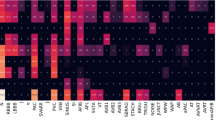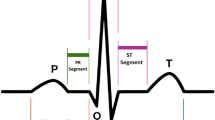Abstract
Different approaches have been proposed in order to achieve knowledge integration for coronary care monitoring applications, usually in the form of expert systems. The clinical impact of these expert systems, which are based only on "shallow" knowledge, has not been remarkable due to the difficulties associated with the construction and maintenance of a complete knowledge base. Model-based systems represent an alternative to these problems because they allow efficient integration of the "deep" knowledge on the underlying physiological phenomena being monitored. In this work, a brief review of existing model-based systems for cardiac rhythm interpretation is presented, followed by the description of a new system forCardiac Arrhythmia Recognition by Model-Based ECG Matching (CARMEM). Fundamental characteristics of CARMEM are presented; in particular, its ability to provide on-line parameter adaptation to simulate complex rhythms and to match observed ECG signals. The proposed model can be useful for the explanation of the origin of cardiac arrhythmias and contribute towards their robust characterization in the context of coronary care units.
Similar content being viewed by others
REFERENCES
Ahlfeldt, H., H. Tanaka, M. E. Nygards, T. Furukawa and O. Wigertz (1987). Computer simulation of cardiac arrhythmias. Computers and Biomedical Research 20: 305–323.
Ahlfeldt, H., H. Tanaka, M. E. Nygards, T. Furukawa and O. Wigertz (1988). Computer simulation of cardiac pacing. Pacing and Clinical Electrophysiology 11: 174–184.
Bardou, A., P. Auger, P. Dumee, R. Farah, P. Bournier and M. C. Govaere (1993). Cellular automata models applied to cardiac arrhythmias. Modelling, Measurement & Control 38: 23–31.
Bardou, A. L., P. M. Auger, P. J. Birkui and J. L. Chasse (1996). Modeling of cardiac electrophysiological mechanisms: from action potential genesis to its propagation in myocardium. Critical Reviews in Biomedical Engineering 24: 141–221.
Berne, R. M. and M. N. Levy (1997). Cardiovascular Physiology. Book News, Inc., Portland, Oregon, USA. 7th Edition.
Bratko, I., I. Mozetic and N. Lavrac (1989). KARDIO: A study in deep and qualitative knowledge for expert systems. The MIT Press, Cambridge, Massachusetts.
Dassen, W., P. Brugada, D. Richards, M. Green, B. Heddle and H. Wellen (1982), A mathematical model of the conduction system to study the mechanisms of cardiac arrhythmias. In: K. L. Ripley (ed.), Computers in Cardiology. Silver Spring MD, Institute of Electrical and Electronics Engineers. Computer Society Press, pp. 407–410.
Denes, P., D. Wu, R. Dhingra, R. J. Pietras and K. M. Rosen (1974) The effects of cycle length on cardiac refractory periods in man. Circulation 49: 32–41.
Gay, J., M. Desnos and P. Benoit (1990). L'Electrocardiogramme. Editions Frison-Roche, Paris.
Guertin, M. (1996). Abductive inference of events: diagnosing cardiac arrhythmias. PhD thesis. Boston University.
Hunter, J. and I. Kirby (1995), Ticker: A Qualitative Model of the Electrical System of the Heart. In: Research and Development in Expert Systems XII, pp. 293–307. Information Press.
Hunter, J., I. Kirby and N. Gotts (1991). Using Quantitative and Qualitative Constraints in Models of Cardiac Electrophysiology. Artificial Intelligence in Medicine 1: 147–164.
Kuipers, B. J. (1986). Qualitative Simulation. Artifitial Intelligence 29: 289–338.
Le Moulec, F. (1991), Etude et réalisation d'un modèle qualitatif profond de l'activité électrique du coeur pour un système de monitoring intelligent en unité de soins intensifs pour coronariens. PhD thesis. Université de Rennes 1.
Malik, M. and A. J. Camm (1991). Cardiac electrophysiological experiments in numero, Part II: Models of electrophysiological processes. Pacing and Clinical Electrophysiology 14: 1648–1671.
Malik, M., T. Cochrane, D. W. Davies and A. J. Camm (1987). Clinically relevant computer model of cardiac rhythm and pacemaker/heart interaction. Medical and Biological Engineering and Computing 25: 504–512.
Michalewicz, Z. (1994). Genetic Algorithms + Data Structures = Evolution Programs. Springer-Verlag, New York.
Mora, F., G. Passariello, G. Carrault and J. P. Le Pichon (1993). Intelligent patient monitoring and management systems: A review. Institute of Electrical and Electronics Engineers. Engineering in Medicine and Biology Magazine 12: 23–33.
Siregar, P., J. L. Coatrieux and P. Mabo (1993). How can deep knowledge be used in CCU monitoring? Institute of Electrical and Electronics Engineers. Engineering in Medicine and Biology Magazine 12: 92–99.
Siregar, P., M. Chahine, F. Lemoulec and P. Le Beux (1995). An interactive qualitative model in cardiology. Computers and Biomedical Research 28: 443–478.
Siregar, P., J. P. Sinteff, M. Chahine and P. Lebeux (1996). A cellular automata model of the heart and its coupling with a qualitative model. Computers and Biomedical Research 29: 222–246.
Siregar, P., J. P. Sinteff, N. Julen and P. Le Beux (1998). An interactive 3D anisotropic cellular automata model of the heart. Computers and Biomedical Research 31: 323–347.
Thakor, N. V., J. M. Ferrero, J. Saiz and G. B. I. (1998). Electrophysiologic models of heart cells and cell networks. Institute of Electrical and Electronics Engineers. Engineering in Medicine and Biology Magazine 17: 73–83.
Uckun, S. (1992). Model-based reasoning in biomedicine. Critical Reviews in Biomedical Engineering 19: 261–292.
Virag, N., J. M. Vesin and L. Kappenberger (1998). A computer model of cardiac electrical activity for the simulation of arrhythmias. Pacing and Clinical Electrophysiology 21: 2366–2371.
Widman, L. E. (1991). The EINTHOVEN system: toward an improved cardiac arrhythmia monitor. In: Annual Symposium on Computers Applied to Medical Care pp. 441–445.
Widman, L. E. and D. A. Tong (1995). An algorithm for complete enumeration of the mechanisms of supraventricular tachycardias that use multiple atrioventricular, AV nodal, and/or Mahaim pathways. Artificial Intelligence in Medicine 7: 361–386.
Widman, L. E. and D. A. Tong (1996). Validation of the EINTHOVEN model-based computerized electrocardiogram rhythm analysis system with three classes of clinical arrhythmias. American Journal of Cardiology 78: 927–931.
Author information
Authors and Affiliations
Rights and permissions
About this article
Cite this article
Hernández, A., Carrault, G., Mora, F. et al. Overview of Carmem: A New Dynamic Quantitative Cardiac Model for ECG Monitoring and Its Adaptation to Observed Signals. Acta Biotheor 48, 303–322 (2000). https://doi.org/10.1023/A:1010285632119
Issue Date:
DOI: https://doi.org/10.1023/A:1010285632119




